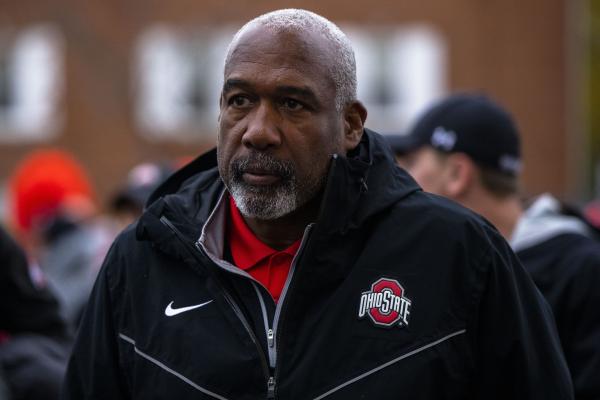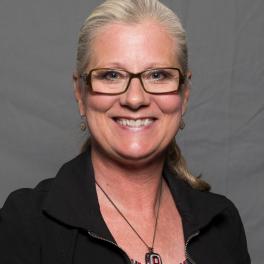Gene Smith and Janine Oman weigh in on Big Ten expansion

By Katy Popovitch and Lauryn Luderman
The Big Ten Conference hasn’t been the “big ten” since expanding to 11 teams in 1990 with the addition of Penn State. As of Aug. 2, it may as well be the “big 18.”

With the June 2022 decision to add UCLA and USC into the conference and the following choice to then adopt Oregon and Washington as of Aug. 4, 2023, the Big Ten will expand from 14 to 18 teams while the PAC-12 collapses.
Gene Smith, senior vice president and Wolfe Foundation athletic director at Ohio State University, said the talks of this expansion began a year before it was officially announced, and the purpose? To grow the program’s worth.
“The biggest thing when you are looking to expand is you want to increase your value,” Smith said. “You are looking for schools that are aligned philosophically and value wise.”
Janine Oman, Ohio State’s senior deputy athletic director and senior woman administrator, said she thinks one of the biggest misconceptions about the conference expansion is that it will impact most of the sports at Ohio State — she said the impact is actually minimal.
“The Big Ten, takeaway football and men’s and women’s basketball, has only nine sports they do conference scheduling on,” Oman said. “It is really only impacting football, men’s and women’s basketball and those nine sports. The other sports are all championship only and other sports, there were no additional members added.”
Although traveling farther distances was a concern in the discussion of expanding the conference, Oman said the Big Ten plans to be efficient and strategic with scheduling road trips. The Big Ten’s medicine cabinet, made up of physicians and athletic trainers across all institutions, and the sports science team have weighed in on how this long travel change will affect athletes’ mental health.
She said the challenge for Ohio State athletes is smaller than those out West, and the goal is to ensure athletes only take one trip to the West Coast per season.
“I think it actually for us is not as big of an impact as it is for the West Coast schools that are coming East,” Oman said.
Both Oman and Smith said the main concern for the athletes is not the travel itself, but the recovery.
“That is why we’ve got to be smart on the backend,” Smith said. “If we come back Sunday, when is your next contest? That is the window that we’ve got to be really smart about.”
Smith said the Big Ten looked at about 21 schools when considering expansion and chose four schools that already had strong brands.
“From an eyeball point of view, they were the schools that brought the most eyeballs to us,” Smith said.
The Big Ten adding more schools that are spread across the country in major television markets will make the conference more competitive, Smith said.
“PAC-12 television was struggling,” Smith said. “They were not making as much in their media agreement as we were and the SEC [Southeastern Conference], we are the top of the pyramid. Those were the schools when you look at the demographics of those environments, they are big media markets.”
On Aug. 18, 2023, the Big Ten reached a new media rights deal with CBS, FOX, NBC and Peacock that will run through the 2029-30 season. When UCLA, USC, Washington and Oregon officially join the conference in August, they will be a part of the deal, according to a release by the Big Ten.
A reason this agreement is suitable with conference expansion is because with the addition of the four schools, Big Ten athletics broadcasting will reach the country’s top-3 markets, including Los Angeles, New York and Chicago, according to the release.
Smith said the expansion is huge for alumni living on the West Coast as well as recruiting athletes in those areas.
“Keep in mind, athletics is the front door to the institution in so many ways,” Smith said. “Oftentimes, it is how the institution is viewed and evaluated which is why we have to do it excellently and be highly competitive.”
The coast-to-coast exposure Big Ten student athletes will get is another positive aspect of the expansion, Oman said.
“I work with lacrosse, and we get a lot of East Coast students that come,” Oman said. “They love the Midwest, and they stay and love to work here. But had they not been here and experienced it, they would be on Wall Street.”
Perhaps Smith and Oman settled any uneasiness with conference expansion as they’ve kept the well-being of their student-athletes at the top of mind, but one concern for many Big Ten athletics lovers might be the infamous Maps commercial, to the tune of “Silver Lining,” by Guards. The commercial that displays during Big Ten contests has captured the hearts of fans as it flows through the landscape of the U.S. hitting on each team in the conference and some of their most popular traditions.
Not to worry, though, Smith said it will be recreated to add the four additional universities.
“They’re gonna recreate it and I think the deal was to show the magnitude of our coverage, but it’s a good commercial,” Smith said.
Many things are set to change this year for Ohio State athletics, conference wise and internally with the departure of Smith, who was instrumental in the Big Ten’s expansion plans.
When his 19-year tenure as athletic director comes to a close June 30, Smith said he will be moving to Arizona to be near family, which, coincidentally will be close to many Buckeyes’ contests on the West Coast, in which he said he’d like to attend.
“I’ll jump up and be a fan in the stands and drink my beer,” Smith said.
